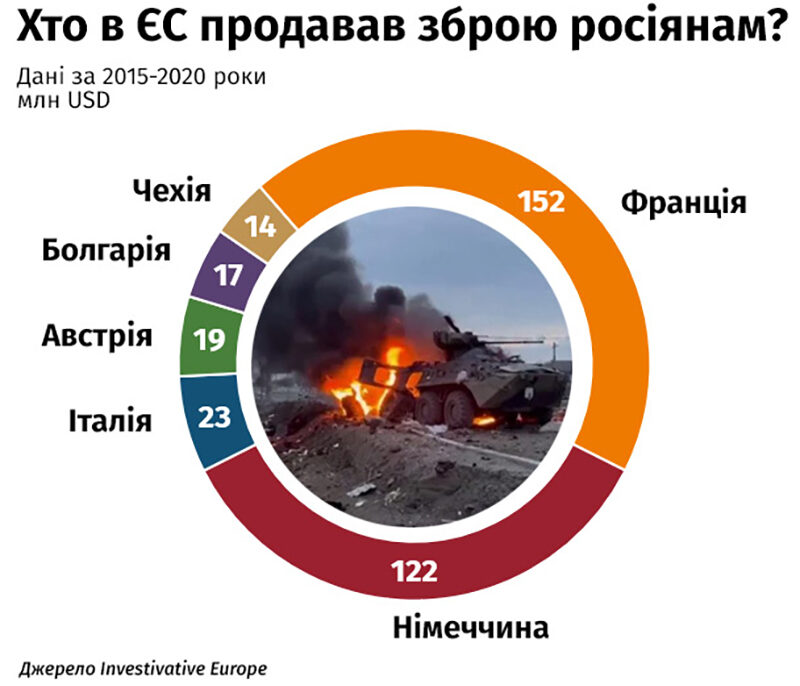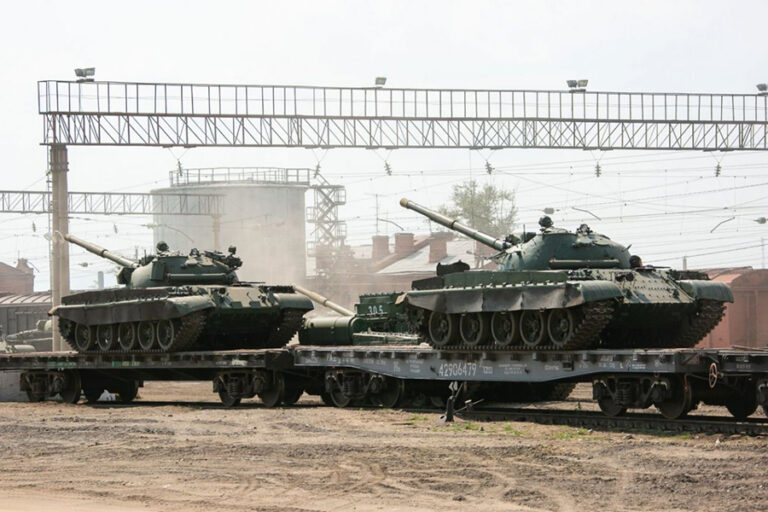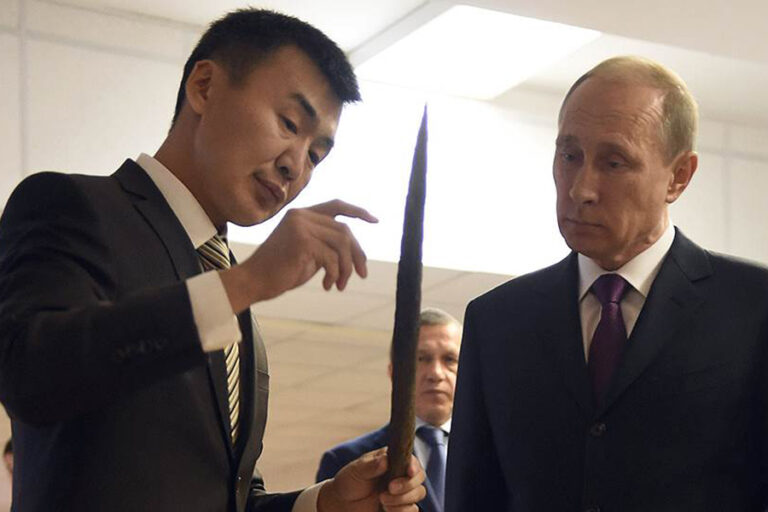
The military-industrial complex (MIC) is one of the most important industries in Russia’s economy. Huge investment and resources were directed there to scale up defensive capabilities (however, in Russia’s case, it is offensive). It was aimed at supporting the image of a great and powerful empire. Russia’s full-scale invasion of Ukraine demonstrated to the whole world that despite the huge amounts of military equipment that was produced by the MIC, the country has been systematically weakened by corruption. Thus, its power is somewhat exaggerated.
According to the report by Global Firepower, Russia has the second most powerful army in the world. But real-life combat is not the same thing as an analytical summary. Failure to predict the army’s readiness for long-term combat operations across a large area or its ability to provide logistics showed that the full and real information about the state of the Russian army was not available or was exaggerated by the propaganda.

Russia loses a significant amount of military equipment on the battlefield during hostilities on Ukraine’s territory. As of August 4, according to the General Staff of the Armed Forces of Ukraine, the Ukrainian army destroyed 4,026 armoured fighting vehicles and 1,789 tanks. This quantity corresponds to 18% and 14%, respectively, of all Russia’s equipment of this type. And the international sanctions limit the possibility of further production. Experts have different forecasts about how long the aggressor can last with its equipment as there is no open and precise data about Russia’s armaments. However, what is the available information about the real state of Russia’s MIC and the sanctions’ effect on its offensive capability?

External factors affecting the MIC of Russia
The first thing that harms Russia’s MIC is the sanctions. Since the beginning of the full-scale war, the EU’s countries imposed 5 sanction packages on Russia, some of its officials, oligarchs, and companies. The USA, UK, Canada, Japan, and Australia imposed their own restrictions on Russia. They seek to weaken Russia’s economy, decrease its military power, and persuade its authorities to stop aggression. You can view all sanctions on the War and Sanctions site. The first measures were imposed back in 2014, after Russia’s occupation of Ukrainian territories — Crimea and parts of the eastern regions of Ukraine. However, Russia bypassed them and continued to purchase foreign spare parts for military equipment production. Over 2015–2020, ten EU countries exported weapons to Russia in the total amount of EUR 346 million, according to the European Conventional Arms Export Council. 80% of the total amount was supplied by Germany and France.

After the collapse of the USSR, Russia made everything possible to increase the quantity of its military equipment and to modernise military factories and enterprises. It made the image of a well-developed military complex. Indeed, the military equipment possessed by Russia is impressive in its quantity. However, the country needs imported spare parts, raw materials, and equipment for the full-scale operations of the military system. The investigations conducted since 2014 show that Russia used spare parts from other countries for production. Thus, in 2018 the volunteers from the Army SOS organisation presented the report about the spare parts of the Russian UAV* Orlan-10 which had crashed on 6 November 2016 into the Azov Sea near Melekine village, Mariupol district. The main parts of the UAV such as engine components are of Chinese, US, French-Italian, and Japanese origin.
UAV
unmanned aerial vehicle, commonly known as a drone.
Until 2020, Russia cooperated with French electronics manufacturer Thales. Tanks and combat vehicles were equipped with the thermal imagers of this company, and machines with this equipment were found in Ukraine both in 2014 and 2022. Foreign parts are also used for the production of equipment that Russia claims to be exclusively domestic. For example, KamAZ trucks work with an American engine and a German gearbox.
Russia has several weak points in its military complex that were deeply affected by the imposed sanctions. One of them is semiconductors. They are needed for the Russian GLONASS navigation system which is used for guiding cruise missiles. Currently, the aggressor uses American GPS as its own system isn’t developed enough. In 2019, Russia stopped working in this field amid the sanctions. Semiconductors developed by Russia include Elbrus and Baikal microprocessors. However, they are manufactured at TSMC’s facilities in Taiwan, and this company stopped exports to Russia after the full-scale invasion. At a hearing in the U.S. Senate on 11 May 2022, Secretary of Commerce Gina Raimondo said that the Russians are already using import substitution – according to the information from the Ukrainian military, Russian equipment is filled with semiconductors from dishwashers and refrigerators.

On March 31, the U.S. Department of the Treasury announced the blocking of companies that supplied high-tech equipment, radio equipment, radio electronics, and microchips to Russia. Thus, the USA and UK imposed sanctions on such Russian companies as Sernia Engineering, Vector Research Center, Mikron, Malberg Limited, etc.
The MIC of Russia has already started to feel the effect of the international sanctions. Starting from 22 March, the factories of the UralVagonZavod (Ural Railroad Car Factory) and Chelyabinsk Tractor Plant stopped their operations, according to the General Staff of the Armed Forces of Ukraine. They manufactured and repaired tanks and armoured vehicles of the Russian Armed Forces, but now they lack imported parts due to the sanctions. Defense Express (Ukrainian media and consulting company) also notes that UralVagonZavod is Russia’s only serial manufacturer of tanks.
In April, Vostochnaya Verf JSC started preparations for the bankruptcy procedure. As Ukrainian intelligence noted, the company suffers from a difficult financial situation and a lack of foreign components, analogues of which cannot be found either in the Russian or Asian markets. Due to this, the company cannot fulfill government orders for the total amount of RUB 35 billion: the construction and supply of two sea tankers, two small missile ships, and two mobile sea berths, repair and maintenance of ships and boats of various types. The production of steering columns, navigation systems, radio stations, and powder charges for naval artillery has been stopped. They also have to stop work and lay off workers.

It is not the only manufacturer that was forced to reduce production and lay off workers because of the sanctions. On May 3, Defence Intelligence of the Ministry of Defence of Ukraine published a letter of the Russian Armed Forces to the government from the Siberian District Civilian Staff Trade Union. The appeal refers to low levels of wages and mass layoffs of workers, as the manufacturer isn’t able to maintain a full staff.
Even if Russia tried to establish equipment and weapons production with full capacity using its own spare parts, this step would require special equipment. Currently, the MIC of Russia uses machines and consumables (or what is left in the stock) from Germany, the USA, and Switzerland. There are no analogues of these devices in Russia, so it is not clear how to organise the work.
Russia also imports raw materials for production. According to the 2021 report of the Accounts Chamber of Russia, the country meets 100% of its needs in titanium, chromium, manganese, and lithium thanks to foreign supplies. Chromium is used to make the hulls of submarines, lithium — in the creation of batteries and nuclear energy, and manganese is used for different types of steel production. Titanium is especially important as it is needed for aircraft construction, including missile manufacturing. For example, this metal is used for the Kinzhal hypersonic missiles, which have already been used in the war with Ukraine. However, as the report states, Russia’s main supplier of titanium is Ukraine (83% of the total amount). This can be explained by the fact that some companies that extract titanium in Ukraine are connected to Russia. In general, a number of large companies that have Russian capital or owners from Russia are still operating in Ukraine. At the same time, a discussion continues in Ukraine, and a legislative framework is being formed for the confiscation of the property of legal entities and private individuals that participated in the aggression of Russia. Ukraine will be able to use these assets to rebuild after the end of the war.
Russia loses a significant amount of its equipment on the battlefield. As of 9 May, Russia experiences a shortage of high-precision ammunition, according to British intelligence. Because of this, the aggressor’s armed forces use more available, but outdated and unreliable ammunition. However, according to Deputy Minister of Defence of Ukraine Hanna Maliar, this is just about the quantity of weapons, and, unfortunately, Russia still has the resources to fight on and continue to manufacture weapons from those stocks of raw materials that it purchased before the sanctions. The volumes will be much smaller, but they will be there.

Russia also will try to normalise its MIC through Asian countries. As Professor Syed Munir Khasru stated, China and India total 18% of Russia’s foreign trade, so it is critical for Ukraine that these countries join the sanctions. Otherwise, the impact on Russia will not be that significant. For example, Russia is India’s largest weapon supplier, so India is interested in the stable functioning of Russia’s military-industrial complex.

However, the Russian authorities are beginning to admit the impact of sanctions. The Minister of Transport of Russia stated that the country has significant problems with logistics. It happened after the international transport and airline companies exited Russia, maritime operators stopped booking ships moving to Russia, and a number of countries closed the sky to Russian aviation. Earlier in March, the Minister of Industry and Trade of Russia Denis Manturov assured that Russia would be able to rebuild the logistics chains affected by the sanctions in 3 to 6 months. But they will do it to ensure demand in countries that are ready to buy Russian goods, and there are not so many of them at the moment.
Internal reasons for weakening of Russia’s MIC
The actions inside Russia also affect its MIC. On 5 May, Defence Intelligence of the Ministry of Defence of Ukraine published the letter of the Tyumen Battery Factory JSC directed to Sergey Sobyanin, Deputy Head of the Operational Headquarters in Combating Economic Sanctions. According to the letter, the actions of Russian officials are even worse than the impact of sanctions. The officials complicated the process of collecting production waste and created space for corruption. In addition, now the electrolyte will be drained from used batteries, polluting the environment with acid.
Military production was also hit by inflation. Defence Intelligence of Ukraine stated that Russia can’t avoid the rise in prices that now are fixed by the state order amid increased prices of raw materials and spare parts for production. As of 7 April, the MIC enterprises put on hold the execution of the state order of the Ministry of Defence of Russia. This was caused by the lack of funds in the budget and the absence of coordination between the government and manufacturers.
One of the key factors that hit Russia’s MIC are the explosions on the aggressor’s territory. Since March, the number of explosions and fires on Russia’s strategic sites, oil and ammunition depots has increased. This affects every level of the new weapon production: from development to direct manufacturing. Oil depots and warehouses were damaged in the Bryansk, Kursk, Belgorod, and Voronezh regions, where the local authorities explained the explosions as violating security measures at facilities. Journalists of the Daily Mirror compiled a map of fires and explosions, of which there are more than 12 as of 22 May, and they have already reached Sakhalin.

One of the most important damaged facilities was the Research Institute of the Ministry of Defence of Russia, which burned down in Tver on 21 April. Its employees developed air defence systems, navigation devices, control, guidance, and orientation systems of ground, air, and space-based devices. The institute has repeatedly received presidential grants and participated in the development of Iskander ballistic missiles, which caused harm to the Ukrainians from the first day of the invasion.
Each of the destroyed enterprises is important for the military industry of Russia, and the restoration of their normal functioning requires resources, money, and time, which Russia is running out of with every day of the war.
We should also note the power of propaganda, which is manifested in the “glorification” of the aggressor’s developments. The machinery, which the propagandists presented as unique and indestructible, has been successfully destroyed by the Ukrainian army. Back in March, an entire division of the Iskander-M operational-tactical ballistic missile systems, that was supposed to have the superpower to break through air defence according to the Russian propaganda, was destroyed near the city of Chernihiv in Sivershchyna. And in April, the Ukrainian electronic warfare specialists together with infantrymen discovered, disorientated, and shot down the UAV Kub-BLA, presented by the Russians at an international exhibition in 2019 as a highly accurate, silent, and easy-to-use device.

With the beginning of the invasion, the extent of corruption within the MIC of Russia was also revealed. Things that were supposed to be improved or were called the “latest developments” in the official documents of Russia turned out to be neglected due to the embezzlement at each stage of their production. In March, the head of the National Agency on Corruption Prevention of Ukraine Oleksandr Novikov sent a letter to the Minister of Defence of Russia Sergei Shoigu with gratitude “for his invaluable contribution to the fact that Russian means and resources for attacking Ukraine were stolen already at the stage of their accumulation near the Ukrainian border.”

The letter also refers to the “unique developments” created amid the corruption such as the protection of Russian T-72 and T-80 tanks, made of cardboard egg trays, and body armour made from cardboard instead of an armoured plate. This list can be also expanded by UAV Orlan-10, which is worth $80,000–100,000, according to Russians. The Ukrainian Army found a plastic cap from a water bottle and a Canon camera in this UAV.


slideshow
Every day Russia loses equipment in battles. However, it still has a significant reserve that will last for some period. At the same time, the sanctions started to affect the MIC of Russia and reduce its ability to both repair equipment and create new one. Without access to foreign technologies, Russia can’t produce modern weapons using solely its own resources. All mentioned is coupled with corruption, massive lay-offs of MIC’s workers, and mysterious explosions at the production facilities. The process of Russia’s loss of its military strength will not be quick, but it has already begun.

